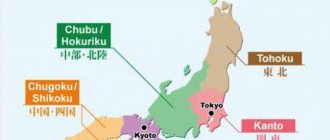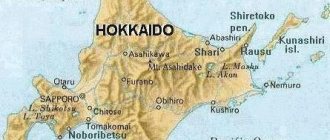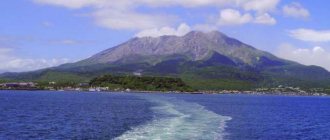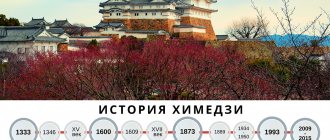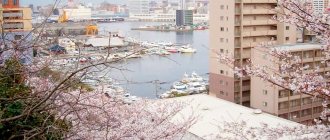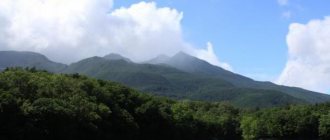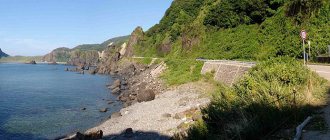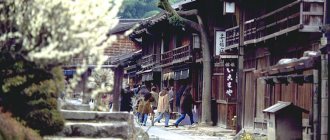Kagoshima from A to Z: map, hotels, attractions, restaurants, entertainment. Shopping, shops. Photos, videos and reviews about Kagoshima.
- Last minute tours
around the world
Kagoshima is the capital of the prefecture of the same name on the southern coast of the island of Kyushu, that is, the very, very south of Japan. Further - only the islands of Okinawa (and even further - Taiwan). It is sometimes called the “Naples of the Eastern World” for its location on a bay (Aira Caldera), hot climate and impressive views of the Sakurajima stratovolcano. True, those who have read “Dream No. 9” by David Mitchell will probably remember that Kagoshima is mentioned there in a slightly different context: for the capital’s residents it is almost synonymous with the edge of the Earth and the bear’s corner. Curious travelers have a good chance to test in practice who more accurately describes reality: guidebooks or fiction.
The landscape and panoramas of Kagoshima are primarily formed by the picturesque Aira caldera. In turn, the caldera itself was formed by a powerful eruption that occurred about 22 thousand years ago. In the center of the caldera you can see the smoking cone of the volcano that gave birth to it, about 16 thousand years old, which still remains one of the most active in the country. The latter adds a certain spice to tourism in Kagoshima.
In the center of the caldera you can see the smoking cone of the volcano that gave birth to it, about 16 thousand years old, which still remains one of the most active in the country.
A little history
For many centuries, Kagoshima Prefecture was the center of the Shimatsu clan's lands, and Kagoshima itself was a bustling political and commercial port city during the Middle Ages and up to the Edo period. Even though international trade in Japan was virtually non-existent at the time, Kagoshima flourished as the center of the semi-independent Ryukyu vassal kingdom. And later Christian missionaries were especially active here. It is believed that the Japanese industrial revolution began here. Finally, it was from Kagoshima that 17 young people, violating the Tokugawa ban on traveling outside Japan, first went to the West, to England and the USA.
In 1945, American bombers dropped more than 800 tons of incendiary and cluster bombs on the city. Kagoshima was chosen as an important Japanese naval base and also a railway terminal. And carpet bombing was preferred to targeted bombing due to cloud cover. As a result, more than 5 sq. km of the city were completely destroyed.
Kagoshima
Story
- 8th century: foundation of the provinces of Satsuma and Osumi on the territory of the conquered Hayato autochthons.
- 1185: Appointment of the head of the Shimazu family as manager of the small Shimazu estate in Satsuma. Gradually, this clan subjugated all of Satsumi.
- 1543: Portuguese arrival on Tanegashima, introduction of firearms to Japan.
- 1574: The Shimazu destroyed the neighboring Kimotsuki clan and annexed the province of Osumi to Satsuma.
- 1575: The Shimazu destroyed the neighboring Ito clan and annexed Hyuga Province to Satsuma.
- 1587: The Shimazu united the entire island of Kyushu under their rule, but were attacked by the forces of the ruler of Japan, Toyotomi Hideyoshi. By order of the latter, their possessions were reduced to Satsuma, Osumi and Hyuga.
- 1592–1598: Shimazu takes part in Hideyoshi's Korean War. For their excellent fighting qualities, Shimazu received the nickname “devils.”
- 1600: Shimazu lost along with the Western Coalition at the Battle of Sekigahara, but retained their possessions. The Satsuma domain was founded.
- 1609: The Shimazu conquer the Ryukyu Kingdom, leaving it formally independent. Trade with this kingdom, which in East Asia had a monopoly on multiple trade transactions with China, makes the Satsuma domain one of the richest in Japan.
- 1779: Sakurajima erupts.
- 1868: The Shimazu take an active part in the Meiji Restoration and become part of the new Imperial government.
- 1871: Kagoshima Prefecture was founded on the basis of the Satsuma domain.
- 1877: The Satsuma Rebellion breaks out under the leadership of Saigo Takamori.
- 1883: Miyazaki Prefecture is separated from Kagoshima Prefecture.
- 1945: Occupation by US troops.
- 1952: The United States returns the Tokarai Islands to Japan.
- 1953: The United States returns the Amami Islands to Japan.
Entertainment and attractions in Kagoshima
One of the most important museums in Kagoshima is dedicated to the Meiji Restoration. In this museum, which stands on the Kotsuki River, visitors are told about a specific, interesting historical period using the most modern technical means. The 3D exhibit on the lower floor of the museum features lighting, sound effects and robots. And on the floor above there is an exhibition dedicated to the people and events of the Satsuma province.
The comparison of Kagoshima with Naples also has the basis that these two cities are sister cities. Kagoshima even has a Naples street, as well as Perth and Miami, its two other sister cities.
Ishibashi Park is one of the few places in Kagoshima where you can see a preserved piece of history. At the end of the Edo period, local ruler Shigehide Shimatsu built five bridges across the Kotsuki River. Two of them collapsed in the 1993 flood, but the remaining three were moved to a new location and rebuilt. In addition to them, in the park, which was opened in 2000, there is a memorial museum.
Kagoshima Botanical Garden, founded in 1971, features a variety of tropical plants from around the world, including palm trees, orchids and cacti.
Many places in Kagoshima are associated with the Satsuma Rebellion: it was here that the semi-legendary samurai hero Saigo Takamori was born.
Kagoshima Prefecture
Kagoshima Prefecture occupies the southern tip of the island of Kyushu and includes several northern islands from the Nansei-Shoto archipelago. The area of its territory is 9132 square meters. km., and the population is 1.7 million people.
During the Edo period, the southern part of the island belonged to Satsuma Province. For several centuries, this region was ruled by the powerful Shimazu clan. In 1866, a military-political alliance was created in Satsuma, uniting the daimyo of several southern provinces of Japan. It was thanks to the support of the Shimazu clan that Emperor Meiji managed to return to power and put an end to the era of the reign of the Tokugawa shoguns.
One of the most famous samurai of that era was Saigo Takamori. It was he who played a leading role in reforming the political system of Japan. However, then he became disillusioned with the consequences of his actions, and, returning home from the capital, rebelled against the new government. Of course, the forces turned out to be unequal, and a few months later the uprising was brutally suppressed. It was these events that formed the basis of the famous film “The Last Samurai” - although its plot is still quite far from the real story.
After the defeat at Kumamoto, Saigo Takamori fled to Kagoshima and committed ritual suicide in a secluded cave. Now his statue is installed in the city center near Chuo Koen Park. The grotto in which the samurai died has also survived to this day, and is now part of the memorial dedicated to the rebels.
Many of Kagoshima's attractions are in one way or another connected with the restoration of the emperor's power and the fate of the brave samurai. For example, the Meiji Restoration Museum displays dioramas and videos telling about the life of Takamori and his comrade Toshimichi.
Another famous historical figure of Kagoshima is the preacher Francis Xavier, who arrived in Kagoshima in 1549. He was warmly received by local residents, despite the fact that it was officially forbidden at that time to practice any foreign religion in Japan. A statue of Xavier is also installed in the capital of the prefecture in the center of the park of the same name.
History buffs should visit the Reimeikan Museum, located at the foot of Mount Shirayama. Its exhibition tells the story of the culture and traditions of Kagoshima - from the prehistoric period to the present day.
Many of Kagoshima's architectural monuments were built for the Shimazu clan of rulers. For example, the picturesque Sengan-en Garden, located north of the prefectural capital, is very popular among tourists. It was built around the residence of Iso in 1658. After the Meiji Restoration, many members of the Shimazu clan took high positions in the new Japanese government. Their villas remained private property for a long time, closed to prying eyes.
Villa Shimazu-ke is now open to visitors. The garden paths offer magnificent views of the sea coast and the active Sakurajima volcano. Also located within the park is the Foreign Pavilion, built for British engineers. Satsuma rulers often invited foreign specialists to build textile factories and railways.
During the era of industrialization, several factories were built in the park. Most of them were dismantled later, but some buildings have survived and are protected by the state as an important historical heritage of the Meiji Restoration. In the premises of former factories, the Shoko Shuseikan Museum is open, presenting the personal collection of the Shimazu family - scrolls, weapons, ceramics, dolls and various tools.
The capital of the prefecture is home to the Natural History Museum, whose exhibition is dedicated to the geography, geology and biodiversity of Kagoshima. The museum complex also includes a planetarium.
Not far from the Sakurajima ferry terminal is the Kagoshima Suizokukan Aquarium, which displays a variety of inhabitants of the warm waters washing the coast of Kyushu - whale sharks, manta rays, dolphins, electric eels and sea otters.
Another popular spot in Kagoshima is the Shiroyama Observatory. This is an observation deck located on the top of a hill 107 meters high. From here you can enjoy excellent views of the surrounding landscape and the Sakurajima volcano rising near the coast. By the way, thanks to the high volcanic activity of the region, Kagoshima can delight tourists with beautiful onsens. The most famous of them are the Nishida and Kagomma complexes.
In addition to the capital, other famous places in this southern prefecture are worth visiting. In the town of Tiran, 34 kilometers from Kagoshima, ancient samurai estates are preserved, surrounded by traditional gardens. There is also a memorial museum for kamikaze pilots who set off on their deadly flight from the airfields of Kagoshima.
A little further, about 50 kilometers from the prefectural capital, is the popular resort of Ibusuki. Lovers of onsens and hot sand baths come here. It is believed that such procedures improve blood circulation, rejuvenate and improve health.
Kagoshima is known for its lush tropical forests and volcanic landscapes. Approximately 9% of its territory is occupied by natural parks, of which the most famous are Kirishima Yaku and Unzen Amakusa. Fans of mountain walks can go to Mount Kaimon - this is an extinct volcano with an almost perfect conical shape, the height of which is 92 meters. On clear days, its top offers beautiful views of the surrounding landscape. And the western coast of Kagoshima receives thousands of cranes every winter - you can admire the graceful birds in the village of Arasaki near Izumi.
Mount Sakurajima rises into the sea near the city of Kagoshima. This is one of the most active volcanoes in Japan - smoke constantly smokes above its caldera, and mini-eruptions occur every day, sending clouds of ash into the air. Sometimes residents even have to use umbrellas if the wind blows dust across the waters of Kagoshima Bay. Due to volcanic dust, growing rice in the prefecture is almost impossible, but daikon radish grows well on the local soil, reaching the size of a basketball.
The Koshikijima Islands, located 30 kilometers off the coast of the Satsuma Peninsula, are famous for their thickets of wild Japanese lilies. At the end of the rainy season, flowers cover the ground with a continuous pink carpet, which attracts many photographers and simply nature lovers to the islands.
Another popular destination is Tanegashima Island. Colorful traditional festivals are held here every year, but the island is famous thanks to modern technologies: there is a cosmodrome here, from which satellites are periodically launched into low-Earth orbit. Tanegashima also produces high-quality blades for Japanese knives and scissors.
Bullfights have been held on Tokunoshima Island for 500 years. This practice is also found in other regions of Japan, but here victory is not counted on points, but in the event of the opponent's escape. During the fight, the trainers are in the arena and encourage the animals in every possible way, and after the winner is announced, they solemnly ride around the circle riding the bulls.
Yakushima Island, located 135 kilometers from the prefectural capital, is recognized as a UNESCO World Heritage Site. An ancient cedar forest grows here and is home to many wild monkeys. Wildlife lovers will be enchanted by deserted beaches and incredibly picturesque tropical landscapes.
The climate of Kagoshima Prefecture is mild but very humid. There are two rainy seasons here, and between May and July, 7 times more moisture falls on the ground than in Tokyo. After the rainy season comes the turn of typhoons - strong storms usually pass over the islands in August and September. Winters in Kyushu are quite cold for the subtropics - about 7 ° C, and snow often falls in the mountainous areas.
The best time to visit Kagoshima is the end of March, when sakura begins to bloom in the parks.
You can get to the southern tip of Kyushu by Shinkansen - the prefectural capital is the terminus of the Hakata-Kagoshima railway line. There is also an international airport in Kagoshima that accepts flights from Korea and China.
Kagoshima cuisine
The entire prefecture and, of course, its main city are especially famous for their culinary traditions. The warm climate and diversity of the surrounding nature make it possible to grow such products in Kagoshima, which are then supplied throughout the country. These top foods include herring, yellowtail, beef, smoked eel, Berkshire pork and chicken, which is often cooked raw like sashimi. Also worthy of attention is "miki" - fermented rice milk, especially popular among residents of the Amami Islands.
But perhaps Kagoshima's most popular delicacy is satsuma-age (or tsuki-age), a kind of fried, puffy pancake made from a mixture of minced fish and flour. The dish has a million variations and many names, but in Kagoshima they believe that the original recipe originated here.
In addition, you should definitely try the country-famous “shochu” - something like fermented vodka made from sweet potatoes. Almost every restaurant in Kagoshima has it and in many variations (even the station bar serves more than 100 varieties of shochu). In Kagoshima, it is customary to drink it diluted with hot water. There are many factories in the city that produce shochu, and some of them offer visitors excursion tours with tastings.
Travel from Tokyo to Kagoshima
Shinkansen
Kagoshima Airport is about 40 minutes from the city. The airport is often a hub for tourists who want to travel to one of Japan's southern islands. Airplane is a popular mode of transport from Tokyo to Kagoshima because the flight takes just under two hours. By train you will be on the road for almost eight hours.
Facts about Kagoshima
Kagoshima has a hotter climate than most other Japanese cities; In August it averages 32 degrees; In January it averages 12.6 degrees; Much more precipitation falls in the summer months than in winter (224 mm versus 79.4 mm); ✅ Kagoshima has several volcanoes, of which Sakurajima Volcano is active; The most important natural resources are titanium, timber and fish;
Go for a walk in Kagoshima
Kagoshima has many different shopping centers and restaurants. The center is easily accessible by numerous trams that go everywhere. Some famous restaurants are Ajimori, Mekkemon and Tonkatsuno Tatei. All three restaurants are typical Japanese restaurants and very expensive.
Spend the night in Kagoshima
You can stay overnight in hotels, guest houses and apartments in Kagoshima. Hotels here are relatively affordable because the city is not super touristy. You can come here in low season for €30.00 per night. Renting a holiday home for tourists is also becoming increasingly popular in the city.
Ryokan, traditional Japanese inn
Views: 1,452
Share link:
- Tweet
- Share posts on Tumblr
- Telegram
- More
- by email
- Seal
Liked this:
Like
Kagoshima events
Kagoshima hosts a variety of events throughout the year, many of which may be of interest to tourists. For example, the sand sculpture festival, which is held here in May. Or a very specific festival of spider (yes!) fights, the tradition of which has existed here, as they say, since the 16th century. Among several July festivals, the umbrella burning festival “Shogadon no Kasayaki” is worth noting. And during the Ohara Matsuri dance festival in November, a colorful and noisy parade takes place through downtown Kagoshima, whose participants dance to traditional music, dressed in summer yukata, happi and bright homemade costumes. This is the largest event of its kind in southern Kyushu and attracts 20 thousand spectators annually.
Attractions in Kagoshima
Kagoshima has a small number of attractions, of which Senganen is the most popular. Other famous attractions are the Church of St. Xavier and the Amuran Ferris wheel.
Senganen garden
Senganen is a traditional Japanese garden that has been rated very well on TripAdvisor (the world's largest travel site). The garden has been in existence for over 350 years and is therefore one of the oldest in Japan. From the garden you can also view the active Sakurajima volcano. The view is impressive!
Church of St. Xavier
Francis Xavier was the first Christian missionary to come to Japan. In memory of him, a stone church was built in 1908. Unfortunately, the church was destroyed during US air strikes in World War II. But in 1949 a new wooden church was built, and in 1999 it was replaced by the current building. The church is open daily, on weekdays and Saturdays from 10 a.m. to 5 p.m., and on Sundays from 10 a.m. to 12 p.m.
Beach in Kagoshima
Thanks to the wonderful warm climate in Kagoshima Prefecture, you can enjoy the beach almost anywhere. Not far from the city there are beautiful sandy beaches and small islands that you can visit. Relaxing in the sun has never been more fun than in Japan!
Amur Ferris wheel
The Amuran Ferris Wheel is one of the main attractions of the city. The wheel has a diameter of 60 meters and at 91 meters is the highest point above the ground. It could compete with the London Eye. One revolution takes about 14 minutes and 30 seconds. Not suitable for people with fear of heights and enuresis!

